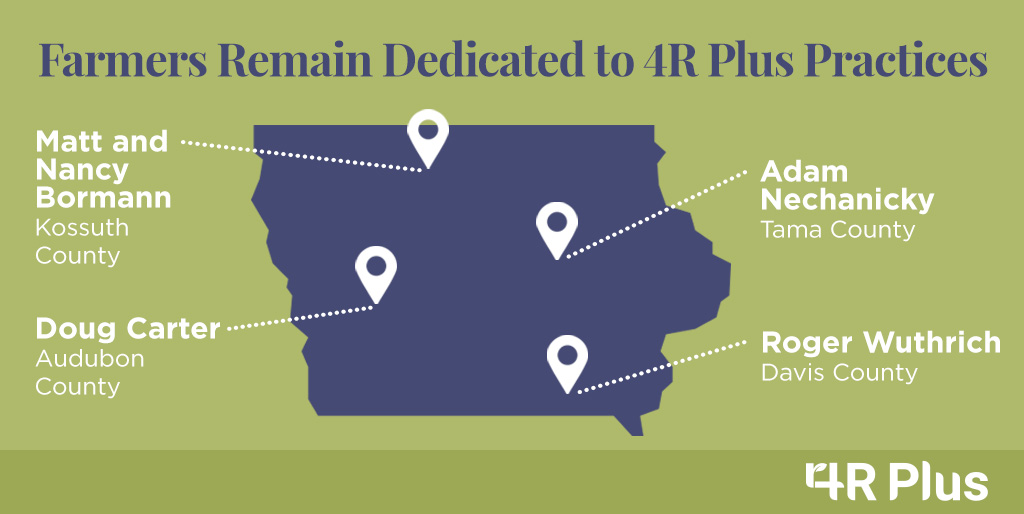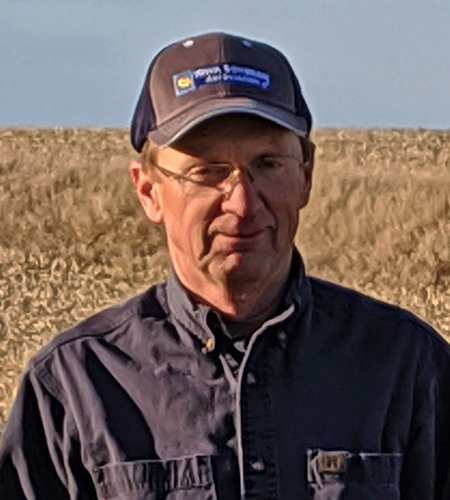
[DES MOINES, Iowa] – A variety of nutrient stewardship and conservation practices are available for Iowa farmers to use to improve soil health and water quality. In 2020, 4R Plus followed four Iowa farmers through the growing season to learn how they used conservation and nutrient stewardship practices on their farms and the benefits they are achieving, despite the challenging weather they faced.
4R Plus involves using precise 4R nutrient stewardship along with conservation practices like no-till and cover crops to achieve a more productive crop now and in the future while protecting Iowa’s natural resources. Each of the farmers recognizes improving soil health is directly tied to crop productivity and has additional environmental benefits.
The 2020 growing season brought difficult farming conditions, including widespread drought and hurricane-strength winds from the August derecho. These challenges served as a reminder to our farmers of the importance of using 4R Plus practices to build resilient soil.
New practices enhance long-term use of no-till

Doug Carter of Audubon County in western Iowa was in the bull’s-eye of severe drought for much of the growing season this year, but he found that his no-till operation has improved his soil’s ability to hold water. Carter made changes to his tillage system 20 years ago to stop erosion on his sloping ground, even though at the time the rate of adoption for no-till was fairly slow and he knew he had a lot to learn. It’s years like 2020 where he easily sees the benefits from his no-till system.
Early soil moisture promoted good root development. “No-till and cover crops helped that early season moisture stay in the soil,” he says. “Given the severity of the drought, I can’t complain about my yields, which were down 15% to 20% from my five-year average.”
Carter was also impacted by the historic derecho and made the observation that where he had previously planted cover crops, his corn crop had a more robust root structure. “On the farm where the corn was flattened, I’ve not had a cover crop,” he says. “Some of my other fields didn’t go down as bad.”
Three years ago, he reached out to the Soil Health Partnership for guidance on adding cover crops and plans to expand acreage when he’s comfortable with the system. “Soil tests show organic matter is improving, and I’m grateful we received timely rains and some warmth this fall. I’m happy with cover crop growth,” he says.
4R Plus practices improve efficiencies

Matt and Nancy Bormann of Kossuth County in northern Iowa have developed a system that improves efficiencies on their farm while investing in their soil, which gives them more time to manage their family’s busy schedule. In 2020, they also benefited from a favorable stretch of weather to get their crops planted in eight days and were able to complete harvest in 2 1/2 weeks.
To improve efficiencies, in their full corn-soybean rotation, soybeans are no-tilled into green cover crops, or vertical-tilled in one pass. Strips are prepared in the fall for spring corn planting. “Fertilizer is precisely placed in strips, which reduces time and fuel because there’s fewer passes across the field,” says Matt. “The system reduces compaction and creates the perfect seedbed. The soil holds more moisture, and nutrients have a greater chance of staying on the field where they belong.”
Preserving soil moisture in this year of extremes was key to building above-trend-line yields. “Strips performed phenomenally for us this year,” says Matt. “They were hands down the best yield.”
The Bormann family was fortunate to have weather on their side after harvest to get strips tilled, cover crops seeded and to reshape a 1,900-foot waterway. “The waterway wasn’t shaped right after years of use,” says Nancy. “We had it designed, hired an excavating company, and the bulldozer came in and we got it seeded down.”
“Adopting 4R Plus practices helps us to be more efficient and competitive,” says Matt. “If the roof on your house leaks or the steel blows off a shed you fix it. Why not invest in the soil? The soil is our future.”
Focused on practices that deliver results

Adam Nechanicky of Tama County in central Iowa farmed through floods, drought and derecho, and through it all, is looking forward to what 2021 brings. He lost yield to the variable weather but saw the benefits of his conservation and nutrient stewardship practices. He says corn yields were down around 40 bu. per acre from his five-year average, and soybean yields were 10 bu. to 15 bu. per acre lower than normal.
About a decade ago Nechanicky switched to a no-till system for soybeans and makes strips in the fall for the corn seed and nutrients. After six years of experimenting, he’s comfortable planting corn and soybeans into green cover crops and is noticing the soil health and economic benefits accumulate.
“I switched tillage programs to control erosion,” he says. “Since adding cover crops, I’ve seen dramatic improvements in soil structure. Now the soil infiltrates more water, and I’m able to get into the field sooner to plant if it’s wet in the spring.”
2020 was a tough year to evaluate overall agronomic programs, but Nechanicky’s advice to farmers is to consider the long-term benefits of 4R Plus practices. “A lot of these practices like cover crops and strip-till don’t capture a return on your investment the first year,” he says. “You can see advantages in a single year, like good weed control from a cover crop, but the payoff is building healthier soils, and keeping the soil in place, long term.”
For 2021, Nechanicky is looking at 60-inch row corn, interseeding a cover crop early to get more growth and then turning his cattle out after harvest. “I had some 60-inch rows this year, but I didn’t get the rye seeded because my seed beans were late, and I needed to concentrate on getting them in,” he says. “I’m satisfied with the yields from the 60-inch rows, so I plan to overseed rye next season. This should help us from overgrazing the pasture and saves from buying hay.”
Determined to stop erosion and build organic matter

Roger Wuthrich of Davis County in southern Iowa switched to no-till and cover crops on as many acres as possible several years ago to eliminate erosion on his highly erodible land. He also observes benefits like improved soil structure that help absorb and conserve moisture, which was important as the 2020 drought set in.
Wuthrich grows corn and soybeans, and recently added organic SRW wheat to diversify income. On the dedicated organic ground, he rotates from winter wheat to corn and then soybeans. Since it’s tilled to control weeds, he always plants a cover crop and is pleased with fall growth. “Cover crops suppress weeds, improve organic matter and hold the soil in place,” he says.
Wuthrich was optimistic for above-average yields early in the season, but after the drought conditions, he’s satisfied that corn and soybeans held close to his five-year average. “Rain events were sparse,” he says. “And when it rained, it was variable.”
As part of his prescribed nutrient plan, manure was applied this fall without any delay. “No two years on the farm are ever the same, and we certainly are dealing with the end result of variable weather this year,” he says. “Even though our yields weren’t as high as I had hoped, we’re thankful for what we’ve got, given the long stretch of dry weather. I have to believe that’s the result of conserving soil moisture and building organic matter in the years where I’ve been able to get cover crops established.”
Join the 4R Plus movement
The more than 50 supporters of the 4R Plus program recognize it will take a combination of nutrient stewardship and conservation practices on farms to meet the Iowa Nutrient Reduction Strategy nonpoint goal of reducing nitrogen and phosphorus loading into Iowa waters by 41% and 29%, respectively.
4R Plus encourages farmers to work with their trusted advisor to determine what 4R nutrient stewardship and conservation practices best fit their unique situation, and to visit their local Soil and Water Conservation District office for information on financial and technical assistance.
To learn more about the 4R Plus farmers featured in this article, visit www.4RPlus.org.
